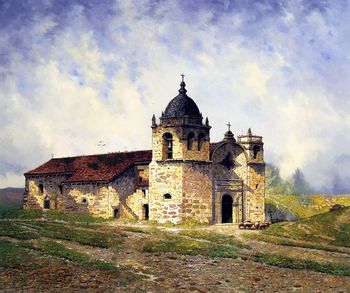Mission San Carlos Borromeo de Carmelo: Difference between revisions
imported>Robert A. Estremo (start article) |
imported>Robert A. Estremo No edit summary |
||
| Line 2: | Line 2: | ||
{| border="1" align="right" cellpadding="2" cellspacing="0" width="300" style="margin: 0 0 1em 0.5em" | {| border="1" align="right" cellpadding="2" cellspacing="0" width="300" style="margin: 0 0 1em 0.5em" | ||
|align="center" colspan="2"|[[Image: | |align="center" colspan="2"|[[Image:Deakin SCB circa 1899.jpg|350px]]'''Mission San Carlos Borromeo de Carmelo, ''circa'' 1899.'''<ref>{{Deakin SCB circa 1899.jpg/credit}}</ref> | ||
|- | |- | ||
!colspan="2" style="color: white; height: 30px; background: #630;"| HISTORY | !colspan="2" style="color: white; height: 30px; background: #630;"| HISTORY | ||
Revision as of 01:28, 13 January 2013
 Mission San Carlos Borromeo de Carmelo, circa 1899.[1] Mission San Carlos Borromeo de Carmelo, circa 1899.[1]
| |
| HISTORY | |
|---|---|
| Location: | Carmel-by-the-Sea, California |
| Name as Founded: | La Misión San Carlos Borromeo del Río Carmelo [2] |
| English Translation: | The Mission of Saint Charles Borromeo of the Carmel River |
| Patron Saint: | Saint Charles Borromeo [3] |
| Nickname(s): | "Father of the Alta California Missions" [4] |
| Founding Date: | June 3, 1770 [5] |
| Founded By: | Father Presidente Junípero Serra [6] |
| Founding Order: | Second [3] |
| Headquarters of the Alta California Mission System: | 1771–1815; 1819–1824; 1827–1830 [7] |
| Military District: | Third [8] |
| Native Tribe(s): Spanish Name(s): |
Esselen, Ohlone Costeño |
| Primordial Place Name(s): | Ekheya [9] |
| SPIRITUAL RESULTS | |
| Baptisms: | 3,827 [10] |
| Marriages: | 1,032 [10] |
| Burials: | 2,837 [10] |
| DISPOSITION | |
| Secularized: | 1834 [3] |
| Returned to the Church: | 1859 [3] |
| Caretaker: | Roman Catholic Diocese of Monterey |
| Current Use: | Parish Church |
| Coordinates: | 36°32′34″N, 121°55′2″W |
| National Historic Landmark: | #NPS-66000214 |
| Date added to the NRHP: | October 15, 1966 |
| California Historical Landmark: | #135 |
| Web Site: | http://carmelmission.org |
Mission San Carlos Borromeo de Carmelo, also known as the Carmel Mission, is a historic Roman Catholic church in Carmel-by-the-Sea, California.
History
The Mission, first established on June 3, 1770 in nearby Monterey (near the native village of Tamo), was named for Charles Borromeo, Archbishop of Milan, Italy. It was the site of the first Christian confirmation in Alta California.[6] In May 1771, the Viceroy approved Father Junípero Serra's petition to relocate the Mission to its current location near the present-day town of Carmel-by-the-Sea.[11] Serra's goal was to put some distance between the Mission's neophytes and the Presidio of Monterey (the headquarters of Pedro Fages, who served as military governor of Alta California between 1770 and 1774, with whom Serra was engaged in a heated power struggle).[12] The original site continued to operate as the "Royal Presidio Chapel" and later became the Cathedral of San Carlos Borromeo. "Mission Carmel" (as it came to be known) was Father Serra's favorite, and being close to Monterey (the capital of Alta California) served as his headquarters. When he died on August 28, 1784, he was interred beneath the chapel floor.
The Esselen and Ohlone Indians who lived near the Mission were taken in and trained as plowmen, shepherds, cattle herders, blacksmiths, and carpenters. They made adobe bricks, roof tiles and tools needed to build the Mission. In the beginning, the Mission relied on bear meat from Mission San Antonio de Padua and supplies brought by ship from Mission San Diego de Alcalá. In 1794, the population reached its peak of 927, but by 1823 the total had dwindled to 381. On November 20, 1818 French privateer Hipólito Bouchard raided the Monterey Presidio, before moving on to other Spanish installations in the south.[13] The Mission was in ruins when the Roman Catholic Church regained control of it in 1863. In 1884 Father Angel Casanova undertook the work of restoration. In 1931, Monsignor Philip Scher appointed Harry Downie t be curator in charge of Mission restoration; it became an independent parish two years later. In 1961, the Mission was designated as a Minor Basilica by Pope John XXIII.
Mission Carmel has been designated a National Historic Landmark by the National Park Service. In 1987, Pope John Paul II visited the Mission as part of his U.S. tour. It is also an active parish church of the Roman Catholic Diocese of Monterey.
Notes
- ↑ (PD) Painting: Edwin Deakin
- ↑ Leffingwell, p. 113
- ↑ 3.0 3.1 3.2 3.3 Krell, p. 83
- ↑ Ruscin, p. 25
- ↑ Yenne, p. 33
- ↑ 6.0 6.1 Ruscin, p. 196
- ↑ Yenne, p. 186
- ↑ Forbes, p. 202
- ↑ Ruscin, p. 195
- ↑ 10.0 10.1 10.2 Krell, p. 315: as of December 31, 1832; information adapted from Engelhardt's Missions and Missionaries of California.
- ↑ Smith, p. 18: The Mission was established in the new location on August 1, 1771; the first mass was celebrated on August 24; and Serra officially took up residence in the newly constructed buildings on December 24.
- ↑ Paddison, p. 23: Fages regarded the Spanish installations in California as military institutions first, and religious outposts second.
- ↑ There is a great contrast between the legacy of Bouchard in Argentina versus his reputation in the United States. In Buenos Aires, Bouchard is honored as a brave patriot, while in California he is most often remembered as a pirate, and not a privateer.